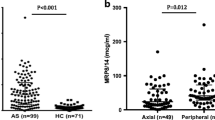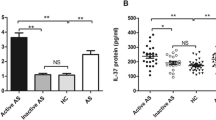Abstract
Monocytes and associated cytokines have been shown to be involved in the pathogenesis of ankylosing spondylitis (AS). T cell immunoglobulin and mucin domain 4 (Tim-4) was identified on monocytes/macrophages and dentritic cells (DCs) and plays important roles in regulating the activities of macrophages and DCs. The current study investigated the association between Tim-4 expression and AS. Our results showed that Tim-4 expression on monocytes and Tim-4 level in plasma were highly increased in AS patients than in controls. Furthermore, TNF-α production and bath ankylosing spondylitis disease activity index (BASDAI) have positive relationships with Tim-4 expression in AS patients. High expression of Tim-4 was thought to contribute to the pathogenesis and an underlying mechanism of AS.



Similar content being viewed by others
REFERENCES
Ward, M.M., et al. 1998. Quality of life in patients with ankylosing spondylitis. Rheumatic Diseases Clinics of North America 24: 815–827.
Ambarus, C., et al. 2010. Pathogenesis of spondyloarthritis: autoimmune or autoinflammatory? Current Opinion in Rheumatology 24: 351–358.
Ma, H., et al. 2013. Genome wide gene expression analysis of macrophages from ankylosing spondylitispatients under interferon-gamma treatment. European Review for Medical and Pharmacological Sciences 17(20): 2798–803.
Chang-Nam, S., et al. 2014. Follow-up testing of interferon-gamma release assays are useful in ankylosing spondylitis patients receiving anti-tumor necrosis factor alpha for latent tuberculosis infection. Journal of Korean Kedical Science 29(8): 1090–1093.
Kuchroo, V., et al. 2003. The TIM gene family: emerging roles in immunity and disease. Nature Reviews. Immunology 3(6): 454–462.
Rodriguez-Manzanet, R., et al. 2008. TIM-4 expressed on APCs induces T cell expansion and survival. The Journal of Immunology 180(7): 4706–13.
Meyers, J., et al. 2005. TIM-4 is the ligand for TIM-1, and the TIM-TIM-4 interaction regulates T cell proliferation. Nature Immunology 6(5): 455–64.
Umetsu, S. 2005. TIM‐1 induces T cell activation and inhibits the development of peripheral tolerance. Nature Immunology 6(5): 447–54.
Miyanishi, M., et al. 2007. Identification of Tim4 as a phosphatidylserine receptor. Nature 450(7168): 435–9.
Albacker, L., et al. 2010. TIM-4, a receptor for phosphatidylserine, controls adaptive immunity by regulating the removal of antigen-specific T cells. The Journal of Immunology 185(11): 6839–49.
Abe, Y., et al. 2013. TIM4 has dual function in the induction and effector phases of murine arthritis. The Journal of Immunology 191(9): 4562–72.
Van der Linden, S., et al. 1984. Evaluation of diagnostic criteria for ankylosing spondylitis: a proposal for modification of the New York criteria. Arthritis and Rheumatism 27: 361–368.
Arends, S. 2014. Higher bone turnover is related to spinal radiographic damage and low bone mineral density in ankylosing spondylitis patients with active disease: a cross-sectional analysis. PloS One. doi:10.1371/journal.pone.0099685.
Li, Zheng, et al. 2013. The T-cell immunoglobulin and mucin domain (Tim) gene family in asthma, allergy, and autoimmunity. Allergy and Asthma Proceedings 34(1): e26–1.
Wang, Y., et al. 2008. Expression of human TIM-1 and TIM-3 on lymphocytes from systemic lupus erythematosus patients. Scandinavian Journal of Immunology 67(1): 63–70.
Khademi, M., et al. 2004. T cell Ig- and mucin-domain-containing molecule-3 (TIM-3) and TIM-1 molecules are differentially expressed on human Th1 and Th2 and in cerebrospinal fluid-derived mononuclear cells in multiple sclerosis. Journal of Immunology 172(11): 7169–76.
Rodriguez-Manzanet, R., et al. 2010. T and B cell hyperactivity and autoimmunity associated with niche-specific defects in apoptotic body clearance in TIM-4-deficient mice. PNAS 107(19): 8706–11.
Kobayashi, N., et al. 2007. TIM-1 and TIM-4 glycoproteins bind phosphatidylserine and mediate uptake of apoptotic cells. Immunity 27: 927–940.
Miyake, Y., et al. 2007. Critical role of macrophages in the marginal zone in the suppression of immune responses to apoptotic cell-associated antigens. Journal of Clinical Investigation 117: 2268–2278.
Wong, K., et al. 2010. Phosphatidylserine receptor Tim-4 is essential for the maintenance of the homeostatic state of resident peritoneal macrophages. PNAS 107(19): 8712–7.
ACKNOWLEDGMENTS
This research was supported by a grant from the Zhejiang Provincial Natural Science Foundation of China (No. LQ13H100001).
Conflict of Interest
The authors have no financial interests to disclose.
Author information
Authors and Affiliations
Corresponding author
Rights and permissions
About this article
Cite this article
Chen, D., He, J., Lu, C. et al. Increased Expression of T Cell Immunoglobulin and Mucin Domain 4 Is Positively Associated with the Disease Severity of Patients with Ankylosing Spondylitis. Inflammation 38, 935–940 (2015). https://doi.org/10.1007/s10753-014-0055-3
Published:
Issue Date:
DOI: https://doi.org/10.1007/s10753-014-0055-3




